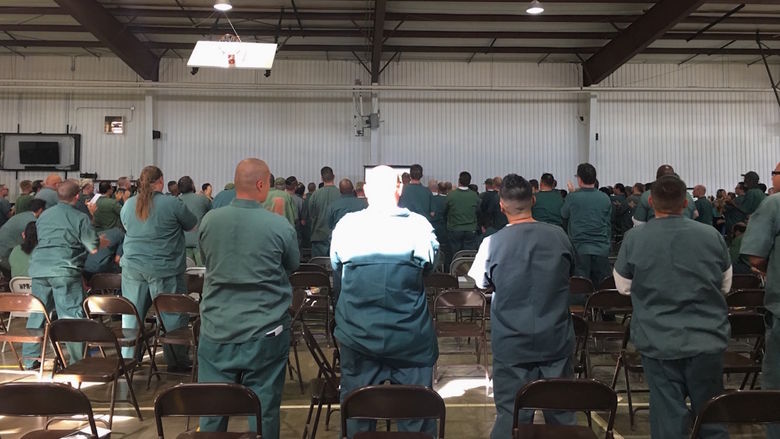
Beaver students Natalie Pollack and Becky Kazmierczyk participate in a shooter scenario for their criminal justice class.
MONACA, Pa. — Natalie Pollack and Becky Kazmierczyk secure their holsters at their hips and check their plastic guns. It’s active shooter scenario day in their Criminal Justice 345 class, and LaVarr McBride, instructor in administration of justice, is about to send them into the auditorium, where a student known as Bruno Mars (McBride has a sense of humor) is threatening his classmates with a gun.
McBride offers some last-minute advice:
"Close the door before you begin your scenario, so passersby don’t call 911."
"Don’t cuff your classmates too tight; they’re not violent criminals."
"The only reason to pull your gun — for your safety or the safety of others."
But Pollack and Kazmierczyk have a more immediate concern — where to put their handcuffs. Their leggings offer no pockets or belt loops.
“We should have worn normal pants,” Kazmierczyk laments.
After finally tucking the cuffs into the back of their pants, Officer Natalie and Officer Becky open the auditorium door and begin their long walk to the stage, where Bruno Mars (played by Travis Young, a Penn State Shenango police officer) holds a knife to his hostage (senior administration of justice major Josh Kelly).
“What’s going on in here?” Kazmierczyk/Officer Becky calls.
“Nothing,” Mars/Young answers, his voice dripping with attitude.
The scenario unfolds in less than five minutes, with Young convincingly playing the part of a dangerous, weapon-wielding student and Pollack and Kazmierczyk doing their best to calm him.
"Sir, put the knife down. We’re going to help you out of this."
"Put the knife down and we’ll put our guns back in … this thing."
"Take your hands out of your pocket."
Criminal Justice 345, Criminal Justice in the Community, teaches students about the multiple entities of the justice system, including social service organizations, law enforcement and the court system.
"This particular course is about understanding what is happening in the community with criminal justice,” McBride said. “I want the students not only to learn what is 'out there,' but to get a sense through these scenario-based events of what it 'feels like' to work in criminal justice within our communities."
Students have already played victim advocates for the women’s shelter. This shooter scenario day is the first part of a two-week lesson that requires students to engage with a shooter, be observant, write a police report and then defend that report in court.
“It’s great because you really get firsthand experience,” said junior administration of justice major Shevon Allen. “This is really what happens.”
Allen was involved in a domestic violence scenario in Student Union Building Room 16 in which he was forced to shoot.
His classmate Taejsha McBride (no relation to her instructor) was in the opposite situation in the SUB stairwell. She walked into a hostage situation without her gun drawn and found herself face-to-barrel with the shooter’s weapon.
She sighed. “Can I start over?”
And she did, but the students know well that’s not the case outside of the classroom. In the real world, as evidenced by recent, high-profile police shootings, officers must make dozens of decisions, big and small, in a matter of minutes to avoid catastrophe. One wrong move, however subtle, can be the difference between a holstered gun and a discharged one.
“You don’t know what to expect,” Allen said.
For Pollack and Kazmierczyk, the unexpected does happen. After a long, fraught conversation, Bruno Mars pulls a weapon from his pocket and fires. Officer Natalie and Officer Becky fire back. Then they lower their arms, guns dangling at their sides.
"How’d we do?"
Young drops his Mars act and smiles.
“The communication was good, the questions you asked were good,” he assures them.
But he suggests they pay more attention to their hostage and always be prepared to draw their weapons. A lesson Taejsha McBride had learned in the stairwell and kept close as she entered a suicide scenario in the Lodge.
“I’m going to try not to die this time,” she said. And then, weapon in her hand, she opened the door.
Learn more about the administration of justice major at Penn State Beaver.


